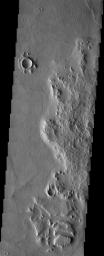
|
Smooth and Scrambled
- Click the image above for a larger view
- Full-Res JPEG (1239 x 3043) (673.0 kB)
- Full-Res TIFF (1239 x 3043) (3.3 MB)
Caption:
Released 19 June 2003
A flat-floored crater in central Arabia hosts an interior crater with interesting ejecta. The scrambled patterns in the ejecta suggest fluidized flow during emplacement. This contrasts with the much smoother terrain on the left side of the image. Although there is some ambiguity, it appears that the smooth material has lapped up onto the ejecta, which raises the question of where the source is for this more recent flow of material.
Image information: VIS instrument. Latitude 2.8, Longitude 37 East (323 West). 19 meter/pixel resolution.
Note: this THEMIS visual image has not been radiometrically nor geometrically calibrated for this preliminary release. An empirical correction has been performed to remove instrumental effects. A linear shift has been applied in the cross-track and down-track direction to approximate spacecraft and planetary motion. Fully calibrated and geometrically projected images will be released through the Planetary Data System in accordance with Project policies at a later time.
Background Info:
NASA's Jet Propulsion Laboratory manages the 2001 Mars Odyssey mission for NASA's Office of Space Science, Washington, D.C. The Thermal Emission Imaging System (THEMIS) was developed by Arizona State University, Tempe, in collaboration with Raytheon Santa Barbara Remote Sensing. The THEMIS investigation is led by Dr. Philip Christensen at Arizona State University. Lockheed Martin Astronautics, Denver, is the prime contractor for the Odyssey project, and developed and built the orbiter. Mission operations are conducted jointly from Lockheed Martin and from JPL, a division of the California Institute of Technology in Pasadena.
Cataloging Keywords:
| Name | Value | Additional Values |
|---|---|---|
| Target | Mars | |
| System | ||
| Target Type | Planet | |
| Mission | 2001 Mars Odyssey | |
| Instrument Host | Mars Odyssey | |
| Host Type | Orbiter | |
| Instrument | Thermal Emission Imaging System (THEMIS) | |
| Detector | ||
| Extra Keywords | Crater, Grayscale, Thermal | |
| Acquisition Date | ||
| Release Date | 2003-06-20 | |
| Date in Caption | 2003-06-19 | |
| Image Credit | NASA/JPL/Arizona State University | |
| Source | photojournal.jpl.nasa.gov/catalog/PIA04585 | |
| Identifier | PIA04585 | |
